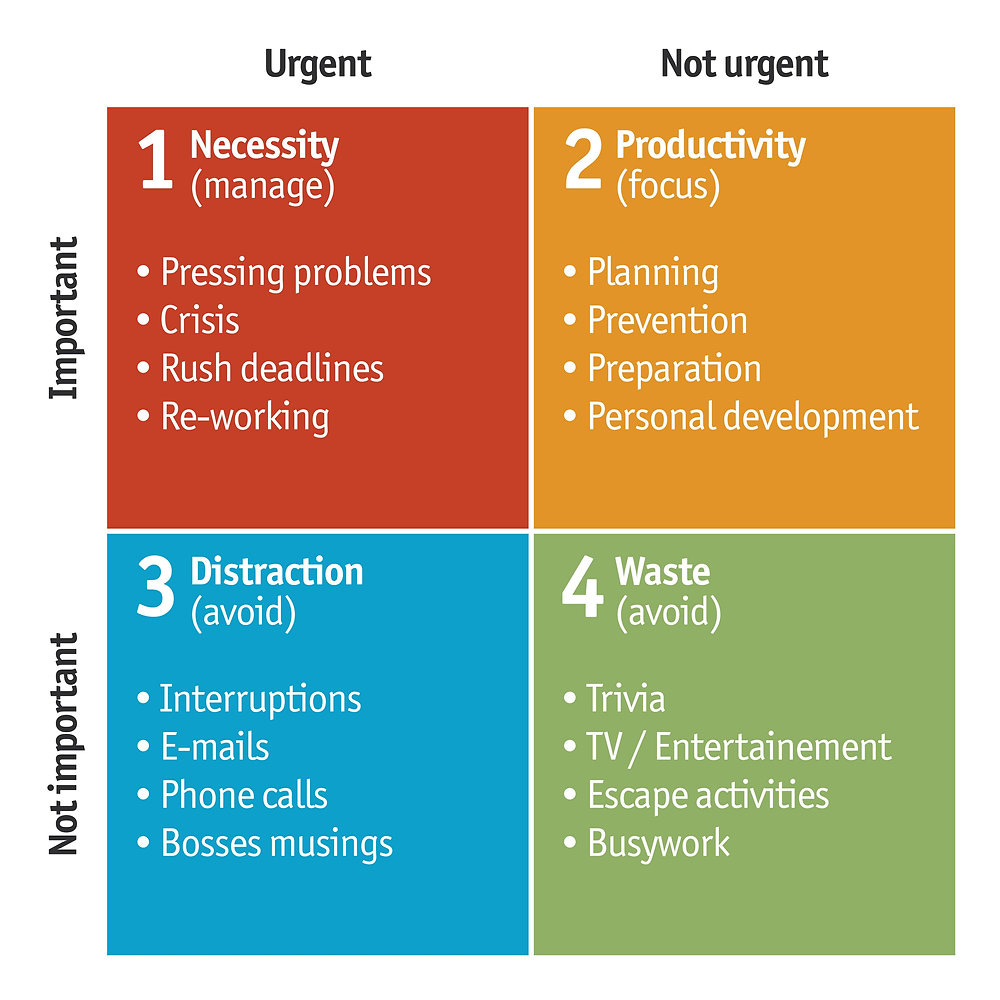Time is the ultimate equalizer. No matter how rich, intelligent, or well-connected you are, you only get 24 hours a day. The difference between the successful and the mediocre isn’t just talent or luck—it’s how they manage those 24 hours.
Picture two men: James and Michael. James is always in a frenzy—answering emails, putting out fires, and working late into the night. He’s constantly exhausted but somehow never really moves forward. Michael, on the other hand, seems calm and in control. He focuses on big projects, rarely seems stressed, and always has time for the gym, friends, and side hustles.
What’s Michael’s secret? He’s mastered the Eisenhower Matrix.
What Is the Eisenhower Matrix?
The Eisenhower Matrix is a simple yet powerful decision-making framework that helps you categorize tasks based on their urgency and importance. It was popularized by Stephen Covey in The 7 Habits of Highly Effective People but originates from Dwight D. Eisenhower, a five-star general, Supreme Commander of Allied Forces in WWII, and the 34th President of the United States. This man was responsible for some of the most critical decisions in modern history—so if anyone knew about prioritization, it was him.
The matrix consists of four quadrants:
Urgent & Important (Do First) – These tasks require immediate attention and have serious consequences if ignored.
Not Urgent & Important (Schedule) – These tasks are crucial for long-term success but don’t require immediate action.
Urgent & Not Important (Delegate) – These are tasks that need to be done immediately but don’t necessarily need you to do them.
Not Urgent & Not Important (Eliminate) – These are distractions and time-wasters that should be cut out of your life.
Why This Matrix Matters
Most people make decisions based on urgency rather than importance. They’re constantly in reactive mode. They’re always dealing with whatever fire is burning the hottest. The result? They stay busy but never make real progress.
Imagine James again. His days are filled with responding to emails, fixing last-minute problems, and handling things that others should be doing. He never gets around to launching the business he dreams of because he’s too busy dealing with trivial tasks. Michael, on the other hand, blocks out time for his most important work, delegates the small stuff, and eliminates distractions entirely.
The Eisenhower Matrix forces you to step back, analyze your workload, and structure your day in a way that maximizes effectiveness rather than just efficiency. Because working hard isn’t the goal—working smart is.
Breaking Down the Four Quadrants
Quadrant 1: Urgent & Important (Do First)
These are your mission-critical tasks—the ones that, if ignored, will cause immediate problems. This includes:
Crucial deadlines (e.g., taxes, work projects, bills)
Emergencies (e.g., a health crisis, legal matters, system failures)
High-impact opportunities (e.g., responding to a major client or investor)
If too much of your time is spent in this quadrant, it’s a sign that you’re either not planning well or constantly putting out fires. James lives here—he scrambles to meet deadlines because he never planned ahead. Michael, though? He minimizes these by prioritizing Quadrant 2.
Quadrant 2: Not Urgent & Important (Schedule)
This is where true growth happens. Quadrant 2 tasks are the strategic, long-term actions that build success, such as:
Learning new skills (e.g., reading, courses, coaching)
Networking and relationship-building
Exercise and health maintenance
Strategic planning (for business, career, personal life)
Michael knows that if he doesn’t schedule workouts, his health will suffer. If he doesn’t work on his side business now, he’ll still be stuck in his job five years later. This is the quadrant where winners spend most of their time.
Quadrant 3: Urgent & Not Important (Delegate)
These tasks feel urgent, but they don’t actually contribute to long-term success. Examples include:
Most emails and phone calls
Unimportant meetings
Random requests from others
James checks his email every 10 minutes and jumps at every notification. Michael? He only checks emails twice a day and lets his assistant handle the small stuff. Your goal is to minimize the time spent on these tasks by delegating, automating, or outright ignoring them.
Quadrant 4: Not Urgent & Not Important (Eliminate)
This is pure wasted time—activities that bring no real value to your life. The usual suspects:
Mindless scrolling on social media
Binge-watching TV
Pointless gossip or arguments
James spends hours on YouTube watching nonsense, then wonders why he’s stuck in life. Michael doesn’t even have social media apps on his phone.
The solution? Audit your time and ruthlessly eliminate what doesn’t serve you.
Applying the Eisenhower Matrix in Real Life
Write down everything you do in a day. Track how you spend every hour for a week.
Categorize tasks into the four quadrants. Be brutally honest.
Prioritize Quadrant 2. Block out time for high-value activities.
Eliminate or minimize Quadrant 4. Cut down on distractions.
Delegate Quadrant 3. Automate or offload unimportant tasks.
Handle Quadrant 1 efficiently. Prevent crises by planning ahead.
This isn’t about becoming a robotic productivity machine. It’s about taking control of your time so you can focus on what truly matters.
Final Thoughts
The men who succeed in life aren’t just working harder—they’re working smarter. The Eisenhower Matrix is a tool to help you stop being reactive and start being intentional with your time.
If you apply this consistently, you’ll experience:
Less stress (because you’re in control, not just reacting to emergencies)
More progress (because you’re prioritizing long-term growth)
Better work-life balance (because you’re cutting out distractions and time-wasters)
At the end of the day, you don’t need more hours. You need to make better use of the hours you already have.
So, the question is: Who are you going to be, James or Michael?




